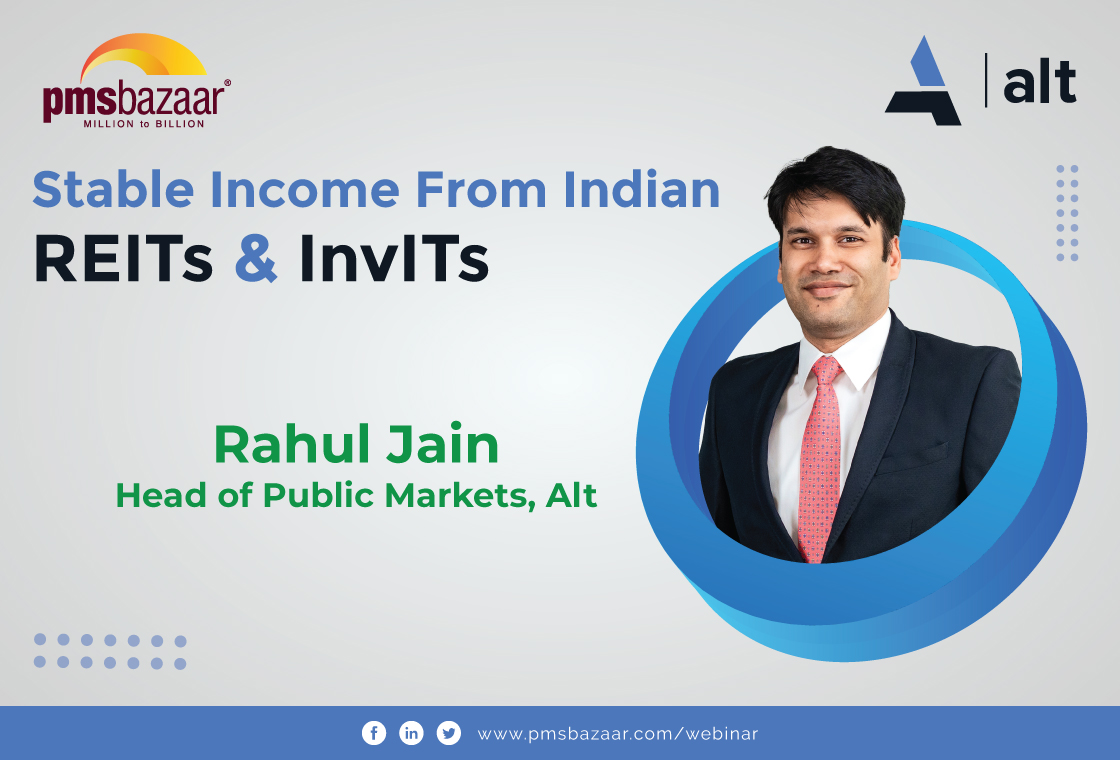India reported the highest foreign direct investment (FDI inflow) to the tune of $83.57 billion for the financial year 2021-2022. Despite the recent FDI Outflow narratives, FDI inflows have actually increased 20-fold in the last 20 years. Supported by GDP growth, favorable demographic inflection, and consistency of government policy, India has embarked upon a ‘Golden Decade’ journey of high investment, consumption, and growth. In this blog, we shall cover the major reasons and future projections that will make this decade a golden period for the Indian economy.

According to experts, the Indian economy is expected to reach $5tn+ this decade, and the data points clearly indicate that the current decade will be a golden decade for India. Recently PMS bazaar conducted a webinar on the topic “India - Golden Decade Ahead” with Mr. Akhil Chaturvedi, Chief Business Officer, Motilal Oswal Asset Management Limited. Several key insights and perspectives were shared by him on India witnessing a “Golden Decade” in the webinar, and this blog covers key insights shared by him.
Key insights covered in this webinar blog are
- Investors should not get deterred by intermittent falls
- Prime Set Up of India’s Decade Ahead
- India Projected to be the Third Largest Economy by 2030
- Wealth Effect if GDP Expansion (2.5$ tn to 6$ tn+)
1. Investors should not get deterred by intermittent falls
Unfortunately, during bull markets, when stocks have been increasing for some time and news has been hyped, investors often rush money into equities, believing that nothing could go wrong with the markets. Some modest individual investors swarm in out of fear of missing out. The same ones panic and bail out after the slightest hint of a correction. They lose a lot of money by purchasing high and selling low.
It has been demonstrated that spanning time periods and market cycles, investors with substantial assets tend to ride out the market and are less concerned with short-term volatility, whereas those with lower quantities of assets lock in losses by selling assets at market lows. When and if they succeed in getting back in, they will already have lost out on several days with significant gains, and the vicious cycle will continue. Therefore, it is preferable to defy the trend rather than sell during a downturn.
Market downturns are normal and cyclical. The journey of the Sensex index since 1997 shows that the Sensex has risen severalfold over the years—thereby indicating that it has created tremendous wealth for investors. However, at the same time, there have been intermittent corrections /volatility from time to time. Maximum drawdown means the maximum loss (in % terms) from the top of the index to the bottom of the index (where the market recovery starts).
The Sensex has seen a maximum drawdown of 56% during the dot-com bubble crash of 2000, a max drawdown of 61% during the global financial crisis of 2008-09, and reasonably large drawdowns in 2013 and 2015 as well. At the same time, it can be observed that these market downturns do not last for too long, and are generally short-lived. Therefore, investors should keep their perspective, stay invested, and not get too carried away by short-term market volatility.
Below is a chart of the corrections, rise, and fall of the Sensex since 1997-

So, fluctuations, volatility, and corrections are common to the Sensex and in normal situations, the Sensex will correct against weak macros. This trend has been witnessed in the past and present and will continue in the future. Hence, investors should not get panic and remain invested in the long term to earn the benefit of good returns. Investors must control their behavior, not be impulsive during such time and be patient.
When facing bouts of market volatility, it is important to not focus on the day-to-day swings but on your longer-term investing goals. Of course, no one likes to see their hard-earned savings diminish. So, investors often ask, “how should I handle market volatility?" and “should I sell stocks when markets are volatile?", that’s why it can be so hard to accept that often the best course during market selloffs is to do nothing.
When times are tough, we want to limit our losses. Even when things are going well, we wish we had invested more. We all fear missing out. But when you’re investing, giving in to fear is often a losing strategy. More often than not, investors with this mindset tend to buy high and sell low as they invest more in a rising market and pull money out in a falling market.
Sometimes it may make sense to adjust a portfolio if conditions seem to suggest that you are not going to make it to your goal if markets have changed. For example, you may need extra resilience against inflation in today’s high inflationary environment. Or you may need added diversification by increasing exposures to other asset classes, like international stocks. In short, making tweaks around the edges of a portfolio may make sense. But trying to time the market to avoid selloffs is extremely difficult because of the risk of missing the rebound. Instead, focus on your longer-term investing goals.
Mr. Akhil Says, “We observe that investors are optimistic about the long-term outlook, but investors are typically trying to time the market or trying to time the bottom, so I believe they are just trying to take a little time to go all out in terms of investing. I would advise against trying to time the perfect bottom because you might not get the perfect bottom, so instead, I would say to keep putting small bouts of money every alternate week every month through SIPs or whatever mode you find comfortable.”
Therefore, we shouldn't worry about these reasons because they will only last for a while before inflation starts to decline as we are currently seeing, interest rates start to decline, and equity markets begin to rise. It may take two or three quarters, so we should be patient until that time.
2. Prime Set Up of India’s Decade Ahead
Know that every 10 years, there will be some other asset class that performs best, and there would be certain asset classes that will give disproportionate returns. For example, if you look at the 1970s, gold was the highest performing asset class with a 13 bagger. The US offered that decade's 13.7-bagger. (Stocks that give returns that are several times their costs are called multi-baggers)

Right, but what transpired in the following decade of the 1980s was that Japan became a 5-bagger, and gold fell by 35%, meaning that what had increased in the prior decade decreased in the following decade. However, Japan had become a 5-bagger by the 1990s, when the market had flattened out and the US had become a 6-bagger. Then, to everyone's surprise, India had become the best performing market in the decade 2000 to 2010, thanks to the 2002 to 2008 6-bagger.
India was the best performing market in the 2000s, while the United States, which was a 6-bagger in the 1990s, actually gave a very muted return of 7%. Now, look at this flipping back in favor of the United States where everyone knows that the 2020s were all about while the U.S. S&P 500 has provided some of the most wonderful returns.
3. India Projected to be the Third Largest Economy by 2030
India’s nominal GDP measured in USD terms is forecast to rise to USD 8.4 trillion by 2030 from USD 2.7 trillion in 2021, making it the third-largest economy in the world. At present, India is the sixth-largest economy in the world, behind the United States (US), China, Japan, Germany, and the United Kingdom. India’s real GDP growth for 2021-22 will be at 8.2%. For 2022-23, GDP growth is forecasted at 6.7%.
India did not rank among the top 10 economies during the 1980s. When we reached the trillion-dollar mark in the economy in 2007, we entered the top 10 economies for the first time since 2000. India took the ninth slot in this decade. China, which was ninth in the decades before, from the 1980s to the 1990s, moved up to the fifth rank & then to the second spot and is most likely on track to overtake the United States as the world's second-largest economy at 30 trillion dollars by 2030.

India, which was previously ranked ninth, is currently in fifth place, very similar to China already. India will regain its position as the fifth-largest economy by 2025 and emerge as the third-largest by 2030 in dollar terms and remain in that position until 2035 while China is now forecast to overtake the US economy in 2028, five years earlier than in 2033 as previously forecast, a top economic research firm has estimated. India, which appears to have been pushed back to being the world's sixth-biggest economy in 2020, will again overtake the UK to become the fifth largest in 2025 and race to the third spot by 2030.
According to Mr. Akhil, “We are only 15 billion dollars away from beating the United Kingdom and joining Germany to join the three to five trillion dollar club for gross domestic product, and from there, we will double our economy from three trillion dollars to six trillion dollars by the year 2030. This is what will move us up to third place and make us the third largest economy, but even after that, we would still be 24 trillion dollars below China, meaning that India's story won't end in just ten years, but rather, it will last for many decades. It will take a long time for us to, you know, get where we want to be.”
India will continue to expand quicker until this occurs and will provide possibilities to profit from stocks since when a country does well, individuals there obviously benefit as well as the businesses that are there that are participating in that growth. Their profits rise faster, which causes their market caps to increase, which in turn causes the market to rise.
4. Wealth Effect if GDP Expansion (2.5$ tn to 6$ tn+)
Everything is ultimately linked to the economy, so the most crucial statistic that you should monitor is how the economy is doing in the short, medium, and long terms. If the earnings growth in the market is tragic, for example, you can decide whether to allocate money to stocks in that manner.

It took the US 12 years to double its economy from three to six trillion dollars, as the United States did between 1978 and 1990. However, as you can see on the right-hand side, US markets delivered a 15 CAGR, demonstrating a correlation between economic growth and stock market growth. As a result, the economy doubled and the stock markets actually increased during this time, that is, went up four times in 10 to 12 years.
Similar to the United States, China doubled its economy from three trillion to six trillion dollars in five years between 2005 and 2010. They did so at a much higher, much faster rate, and extremely quickly, so they did it within five years. However, their markets only returned 31% as a result of their faster growth and getting to doubling much sooner than the United States did.
Our growth path began, slowed down a little during the time of COVID, and is now back to twelve and a half percent CAGR, which indicates that this journey began in 2019 and would take 11 years to complete from 2019 to 2030. As of now, we are now at three trillion dollars, and in a few months, we should reach 3.1 trillion dollars.
With the rupee weakening, it is happening a little faster, but we are already very close to reaching the three trillion dollar market cap club. Therefore, if the US did a 15% CAGR, China did a 31& CAGR, and India has done a 15% CAGR for the last 40 years, there is no reason to think we cannot do a 15 CAGR for the next 10 years.
Mr. Akhil Chaturvedi covered all the above-mentioned topics in-depth and answered some questions from the audience towards the end of the session. Watch the recording of this insightful session through the appended link below:
Get access to rich data and analytics of PMS & AIF by subscribing to us. Join the 40000+ investors & experts now: Subscribe NOW
Recent Blogs
.jpg)
Passively Active Investing — A Modern Investor’s Lens on ETF-Based PMS
PMS Bazaar recently organized a webinar titled “Passively Active Investing — A Modern Investor’s Lens on ETF-Based PMS,” which featured Mr. Karan Bhatia, Co-Founder and Co-Fund Manager , Pricebridge Honeycomb ETF PMs. This blog covers the important points shared in this insightful webinar.

Spot the Trouble: Red Flags in Equity Investment Analysis
PMS Bazaar recently organized a webinar titled “Spot the Trouble: Red Flags in Equity Investment Analysis,” which featured Mr. Arpit Shah, Co-Founder & Director, Care Portfolio Managers. This blog covers the important points shared in this insightful webinar.

Long-Only AIFs Rebound Sharply in October; Long-Short Strategies Lag Despite Lower Volatility
106 long-only AIFs averaged 3.68% vs 32 long-short AIFs at 2.7%; only 24–31% of funds beat key indices

Markets log strongest monthly gains in 7 months; PMS performance turns near-uniform in October
Nifty 50 TRI gained 4.62%, BSE 500 TRI rose 4.27%; 415 of 427 equity PMSes ended positive

How SMEs are Shaping India’s Investment Landscape?
PMS Bazaar recently organized a webinar titled “How SMEs are Shaping India’s Investment Landscape?” which featured Mr. Shrikant Goyal, Fund Manager, GetFive Opportunity Fund.

Stable Income from Indian REITs and InvITs
PMS Bazaar recently organized a webinar titled “Stable Income from Indian REITs and InvITs,” which featured Mr. Rahul Jain, Head of Public Markets, Alt.

5 Key Considerations Before Investing in AIFs in India
Alternative Investment Funds (AIFs) have emerged as a compelling option for sophisticated investors seeking diversification and potentially superior returns. But venturing into AIFs requires a clear understanding of their unique characteristics that go beyond simply knowing what they are and their categories.

How AIF can help in diversification?
Traditionally, Indian investors have relied on a mix of stocks and bonds to build their wealth. While this approach offers diversification, it can still leave your portfolio vulnerable to market fluctuations. Enter Alternative Investment Funds (AIFs), a dynamic asset class gaining traction for its ability to unlock diversification beyond the realm of conventional options.

